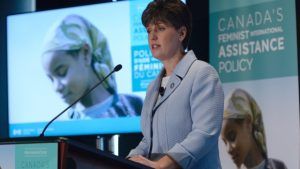Canada's Feminist International Assistance Policy: Key Points for CanWaCH partners
Canada’s Feminist International Assistance Policy: CanWaCH Key Facts
June 9, 2017
Download PDF Version of this Document
Overview
The policy commits Canada to a new feminist approach to international assistance that seeks to support the economic, political and social empowerment of women and girls. Recognizing that inequalities exist along intersectional lines, the policy places gender equality as a targeted pillar as well as a cross-cutting theme of action. Canada’s Feminist International Assistance Policy is aligned with Agenda 2030 and the Paris Agreement, and places emphasis on investments, partnerships and advocacy efforts that the government views to have the greatest potential to close gender gaps, eliminate barriers to gender equality and help achieve the Sustainable Development Goals (SDGs). It centers on SDG 5—achieving gender equality and empowering all women and girls—as the entry point to drive greatest impact for Canada’s international assistance.
“Focusing Canada’s international assistance on the full empowerment of women and girls is the most effective way for our international assistance to make a difference in the world. Sustainable development, peace and growth that works for everyone, are not possible unless women and girls are valued and empowered.”
– Marie-Claude Bibeau, Minister of International Development and La Francophonie
A Feminist Approach Defined:
A feminist approach is much more than focusing exclusively on women and girls; rather, it is the most effective way to target the root causes of poverty that can affect everyone: inequality and exclusion.
Key Points Related to Women and Children’s Health
Under Action Area #1: Gender Equality and the Empowerment of Women and Girls
- Address the unacceptably high rates of sexual and gender-based violence (SGBV) experienced by women and girls, including providing psycho-social support for survivors of violence. Health care positioned as one of the sectors needed to support survivors and bring perpetrators to justice. SGBV includes child marriage, forced marriage and female genital mutilation / cutting.
- Engaging a broad range of stakeholders—including men and boys to transform unequal power relations, systemic discrimination, and harmful norms and practices, with special mention of the important to transform the attitudes of adolescent boys.
- Provide better support for local organizations and movements that advance women’s rights.
- Step up commitment to evidence-based decision making by investing in policy research, better data collection and evaluation for gender equality.
Under Action Area #2: Human Dignity
- Area focus is on access of the poorest and most vulnerable to good health care and nutrition, quality education and timely humanitarian assistance.
- Continued efforts include: fighting infectious diseases such as polio, AIDS, tuberculosis and malaria—and helping to make these services more accessible.
- Focus efforts on programs and projects that put gender at the heart of efforts to improve health care such as fight infectious diseases through equity-based approaches and a focus on diseases, such as HIV, that particularly affect women and girls, that empower community health care workers, and that address the ongoing challenge of SGBV.
- Follow through on 2015 to 2020 commitment to invest $3.5 billion in MNCH programs that strengthen health and data systems, improve nutrition and combat infectious diseases.
“Women’s rights are human rights. This includes sexual and reproductive rights – and the right to access safe and legal abortions. These rights are at the core of our foreign policy.”
– Chrystia Freeland, Minister of Foreign Affairs
- Work to close persistent gaps in SRHR for women and girls through supporting increased access to a full range of health services, including family planning and modern contraception; comprehensive sexuality education; safe and legal abortion, and post-abortion care; and prevention and treatment of HIV/AIDS and sexually transmitted infections.
- Join global partnerships that promote SRHR for women and girls such as Family Planning 2020 and the Ouagadougou Partnership.
- Improved access to nutritious foods and supplements, reducing prevalence of anemia and improving birth outcomes, and advocate for more gender-responsive nutrition policies including through the Scaling Up Nutrition movement.
- Strengthen SGBV prevention and response strategies in humanitarian settings and dedicate a portion of humanitarian assistance funding to providing counselling and psycho-social support.
- Promote use of sex- and age-disaggregated data by humanitarian partners to ensure the needs of women and girls are better understood and responded to.
- Support the full range of women and girls’ sexual and reproductive health needs during humanitarian responses and raise the importance of this kind of targeted assistance with international partners and at international events in the humanitarian system.
Under Action Area #4: Environment and Climate Action
- Women participate actively in the design and implementation of climate change mitigation and adaptation initiatives and resilience-building.
Under Action Area #5: Inclusive Governance
- Strengthen legal systems and promote reforms that eliminate all forms of discrimination against women and girls that prevent them from realizing their economic, political and social rights their economic, political and social rights
Funding Announcements and Responsive International Assistance
2017 – 2018 Planned IAE Spending*
NOTES:
*Final Information on IAE spending, including year-end adjustments, will be made public through the Public Accounts of Canada and Canada’s annual Statistical Report on International Assistance. Information on actual accomplishments against plans, priorities and expected results set out in Departmental Plans will be reported in the Developmental Results Report. Planned figures have been rounded.
**Includes $14M for Environment and Climate Change Canada and $53M for the Asian Infrastructure Investment Bank
***This amount does not include $184M that would be re-profiled from unused 2016-20
